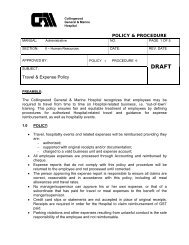Thank You... - Collingwood General & Marine Hospital
Thank You... - Collingwood General & Marine Hospital
Thank You... - Collingwood General & Marine Hospital
Create successful ePaper yourself
Turn your PDF publications into a flip-book with our unique Google optimized e-Paper software.
The race to save her life.<br />
The race to save her life.<br />
New Year’s Day 2008 started off quietly at the Gowing household in <strong>Collingwood</strong>.<br />
Day Gowing and her husband John woke up in the cottage along the Georgian Bay<br />
shoreline that they had renovated seventeen years earlier. With family and friends safely<br />
returned to London, Ontario after the Christmas Holiday, Day decided it was time to see a<br />
doctor about the gnawing pain in her abdomen she had been experiencing for the<br />
past two days.<br />
The snow was falling lightly as John and Day walked up to the Emergency entrance of<br />
the <strong>Collingwood</strong> <strong>General</strong> & <strong>Marine</strong> <strong>Hospital</strong>. Both had been to the G&M in the past for<br />
routine testing. They felt the physicians and staff were helpful and competent although<br />
it did not compare with the renowned London Health Sciences Centre they had counted<br />
on for care prior to moving to <strong>Collingwood</strong>. They had no idea that Day’s case would test<br />
the knowledge, expertise and responsiveness of the G&M’s emergency team in a race to<br />
save her life.<br />
Dr. Darryl D’Costa was the emergency physician on duty that day. When he began to<br />
examine Day, he noticed tenderness in her abdomen. Given her symptoms, Dr. D’Costa<br />
ordered an x-ray. Although a basic diagnostic tool, x-ray technology delivers a very low<br />
dose of radiation to the patient and can be used to “rule out” many problems quickly.<br />
Based on the x-ray results, however, Dr. D’Costa ordered a CT scan to view Day’s<br />
liver in more detail.<br />
With no radiologist in-house on New Year’s Day, Day’s CT scan was immediately sent<br />
through a secure internet connection to be read by a radiologist located in Barrie.<br />
Dr. D’Costa’s suspicions were quickly confirmed. Day was suffering from a hepatic artery<br />
aneurysm, an extremely rare condition experienced by only one quarter of one percent<br />
of the population. Early diagnosis of these cases is critical as the potential for the<br />
aneurysm to rupture and cause massive internal bleeding is very high.<br />
In a small rural hospital like the G&M, the role of the Emergency Team is to quickly and<br />
accurately diagnose and then do whatever is necessary to stabilize the patient prior to<br />
transferring to a larger centre for follow up care. The G&M Team immediately began<br />
the process on Day. A vascular surgeon and bed were quickly located in Toronto and<br />
because the light snow had turned into a full blown storm, the decision was made<br />
to transfer Day by land ambulance.<br />
“I don’t remember a lot about that day,” says Day Gowing. “But I do remember<br />
the ambulance driver and my nurse, Cathy Maecker saying to me: ‘relax, we’ll get<br />
you there’”.<br />
As the ambulance neared Highway 400, Day’s condition quickly deteriorated. A quick<br />
assessment of the situation determined that Day would die before reaching Toronto if<br />
she was not re-stabilized. The ambulance returned to <strong>Collingwood</strong> where the Emergency<br />
Team was once again able to get Day’s vital signs under control.<br />
A second ambulance ride to Toronto <strong>General</strong> <strong>Hospital</strong>, three surgeries and thirty-one<br />
days as an inpatient have allowed Day to lead a full and active life back in <strong>Collingwood</strong>.<br />
It is with great gratitude that Day tells the story of her ordeal.<br />
“I want everyone to know the story of how great my care was,” says Day. “I remember<br />
the surgeon in Toronto telling me that if it hadn’t been for the <strong>Collingwood</strong> G&M <strong>Hospital</strong>,<br />
I wouldn’t be here!”<br />
Day’s diagnosis was extremely rare and could have been missed by staff at the biggest,<br />
best equipped hospitals in the world but the rest of her story is not unique. Over 30,000<br />
patients seek care in the G&M’s Emergency Department every year. Sixty percent of<br />
these patients are triaged as urgent, emergent or resuscitation, meaning that their<br />
conditions can be life threatening. Patients rely on the knowledge and expertise of the<br />
physicians and staff delivering care. The medical professionals are assisted by medical<br />
technology to diagnose and treat patients.<br />
“The physicians and staff at the G&M <strong>Hospital</strong> depend on sophisticated medical<br />
technology to help save lives every day,” explains Dr. Darryl D’Costa. “We are so grateful<br />
to our community for funding the tools we need to care for our patients.”



